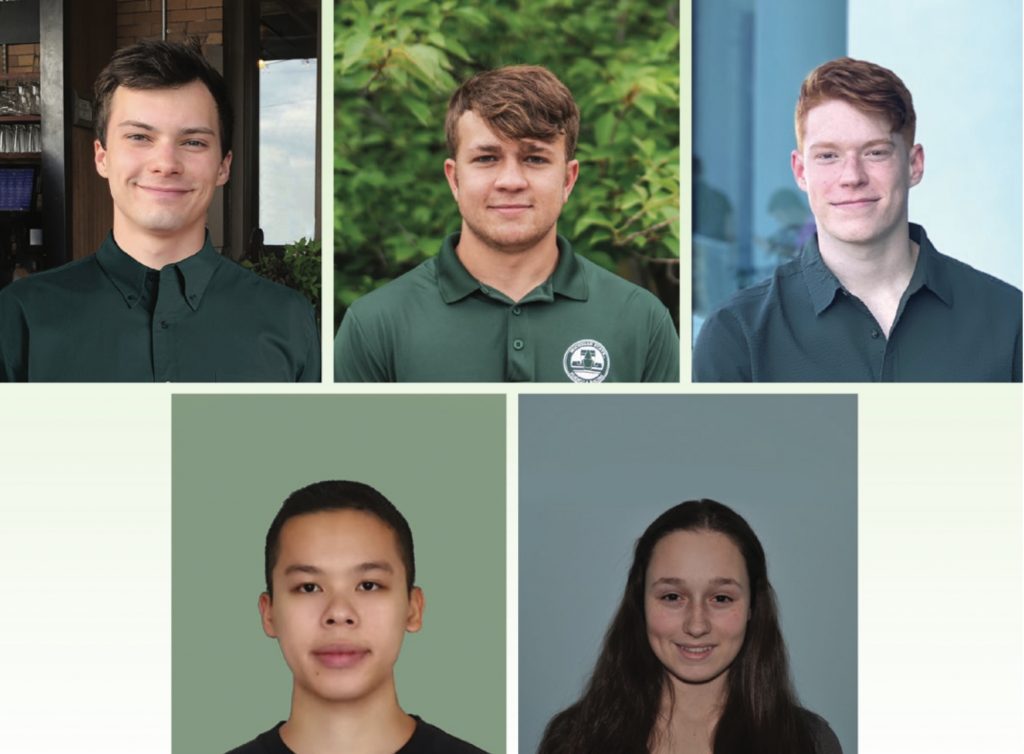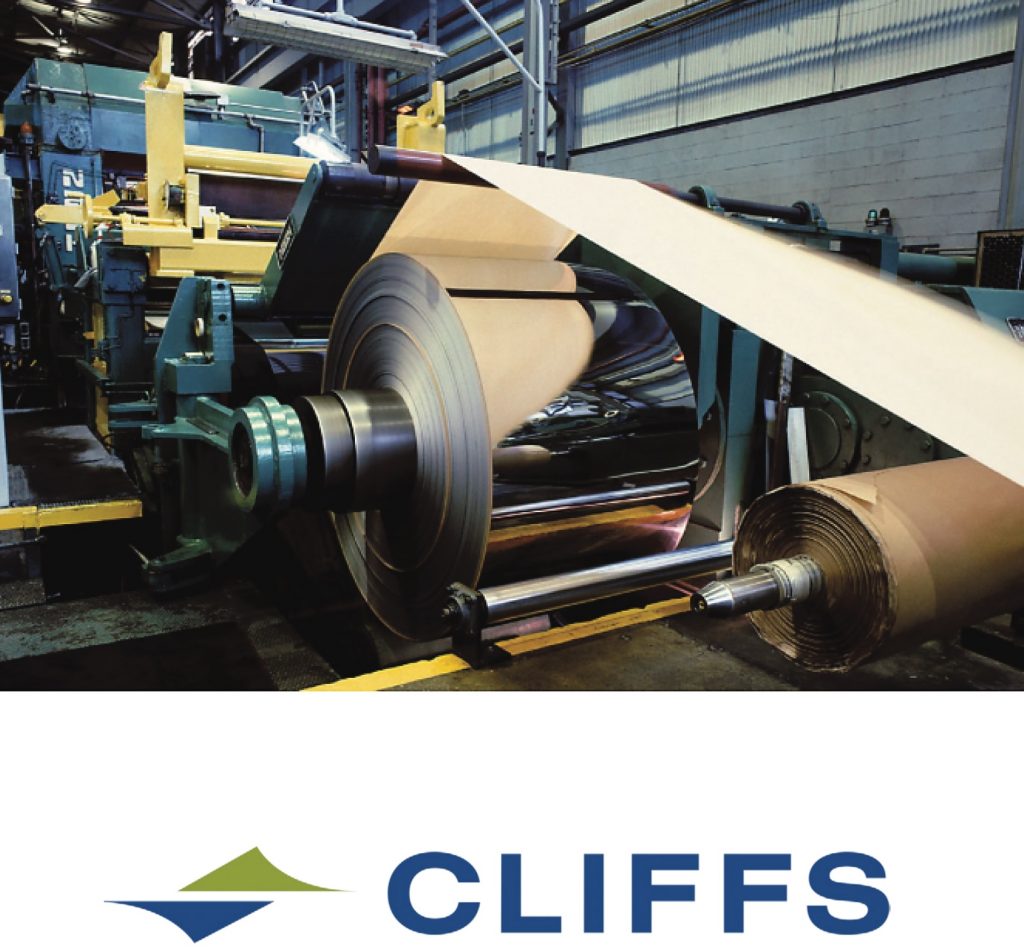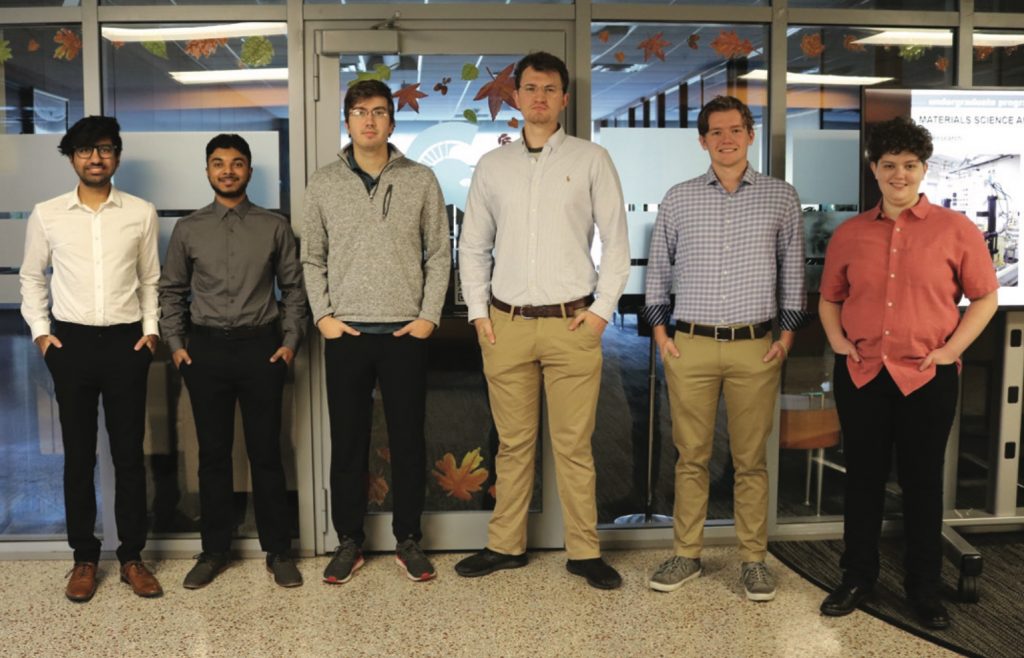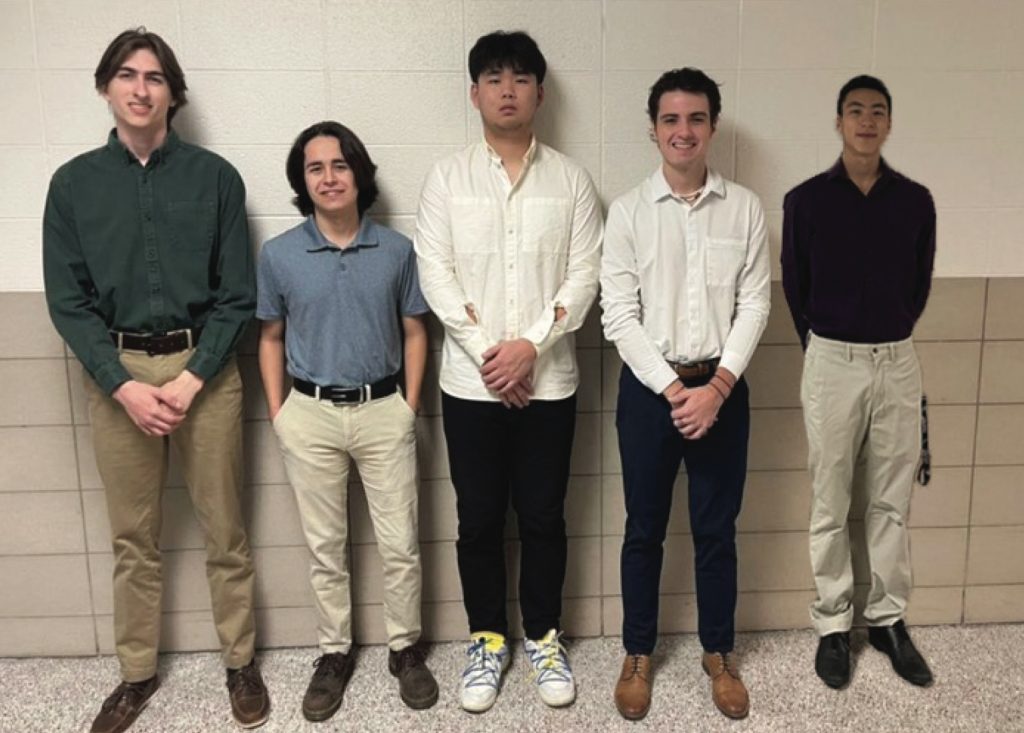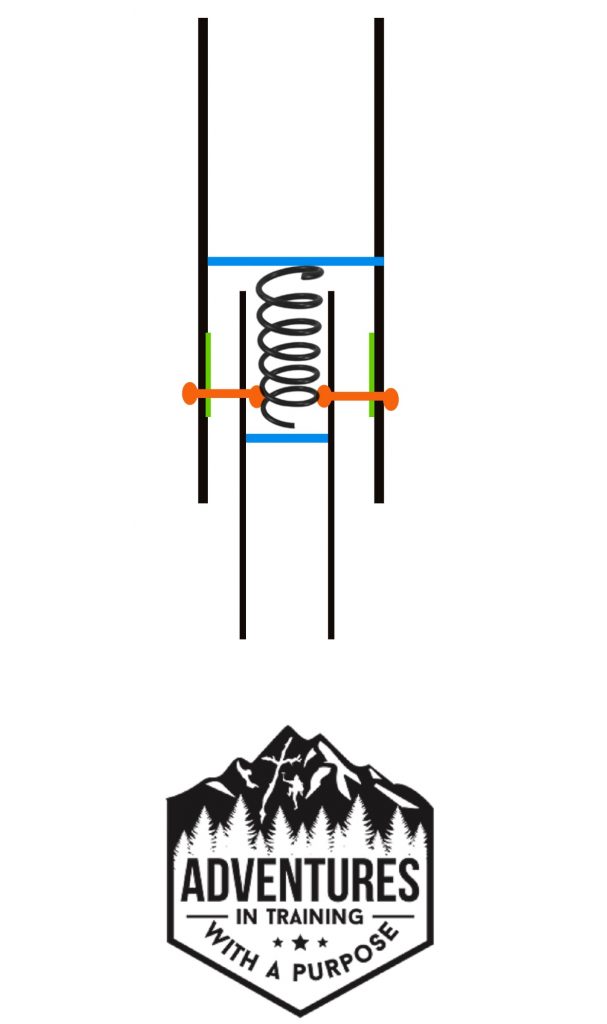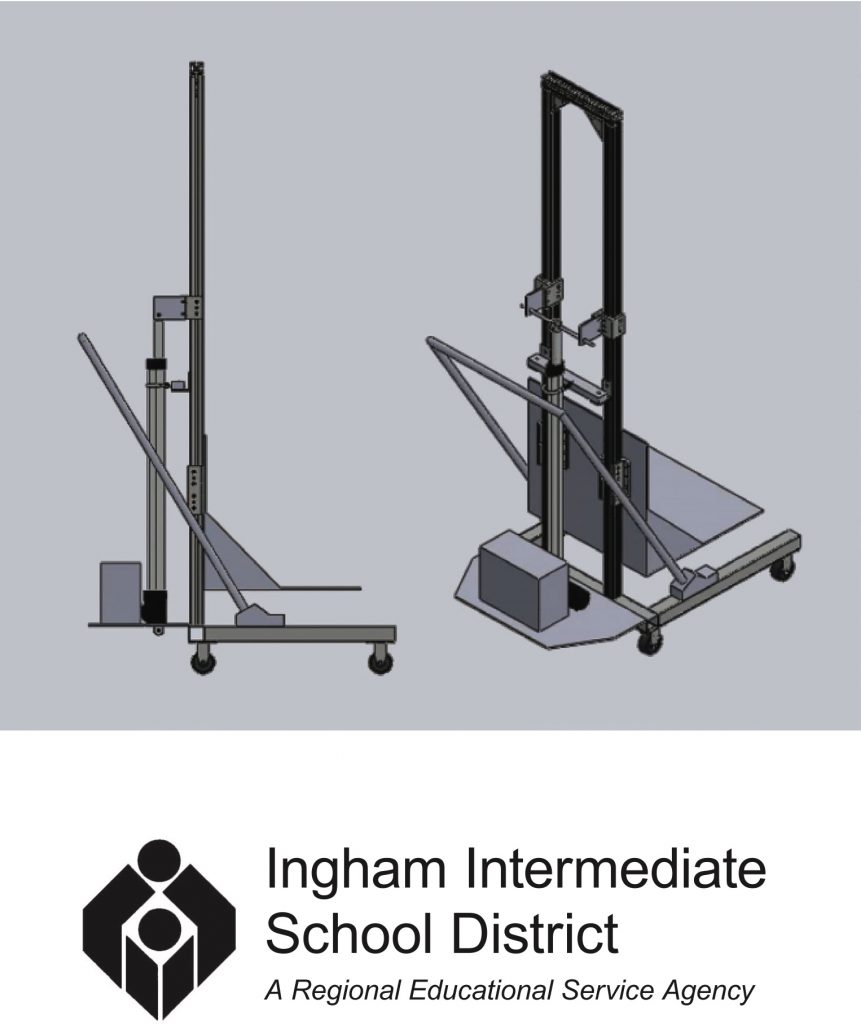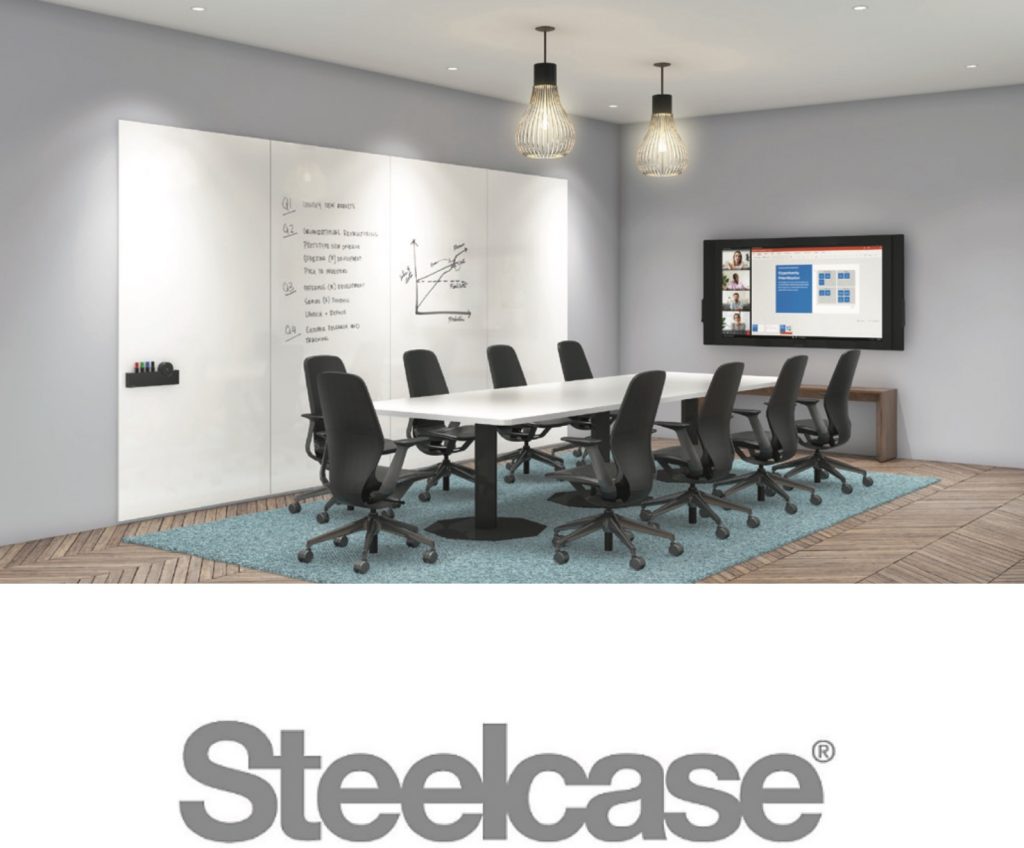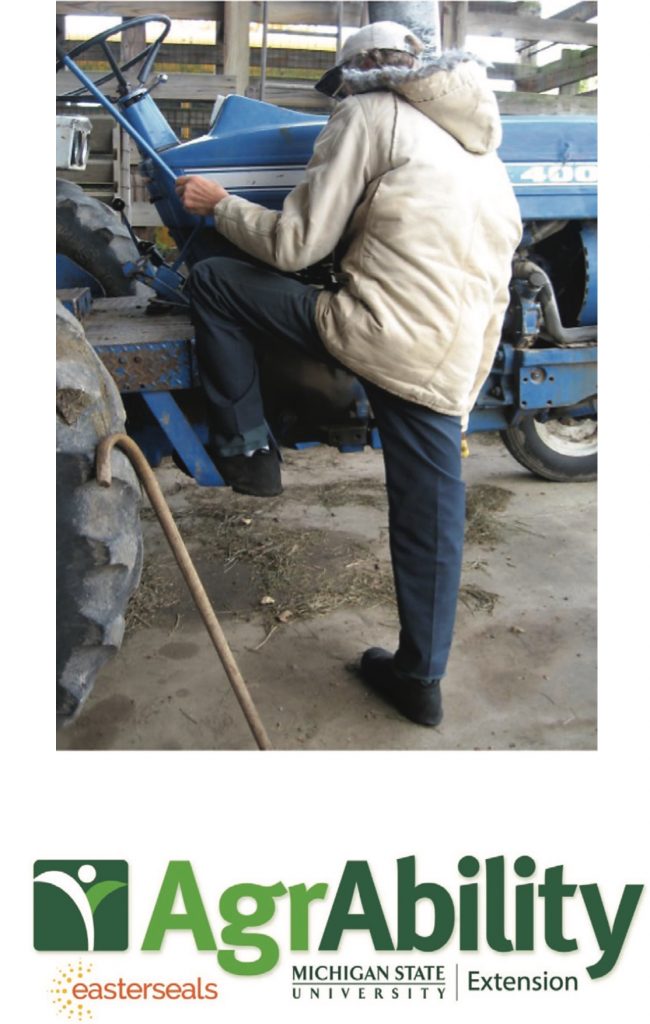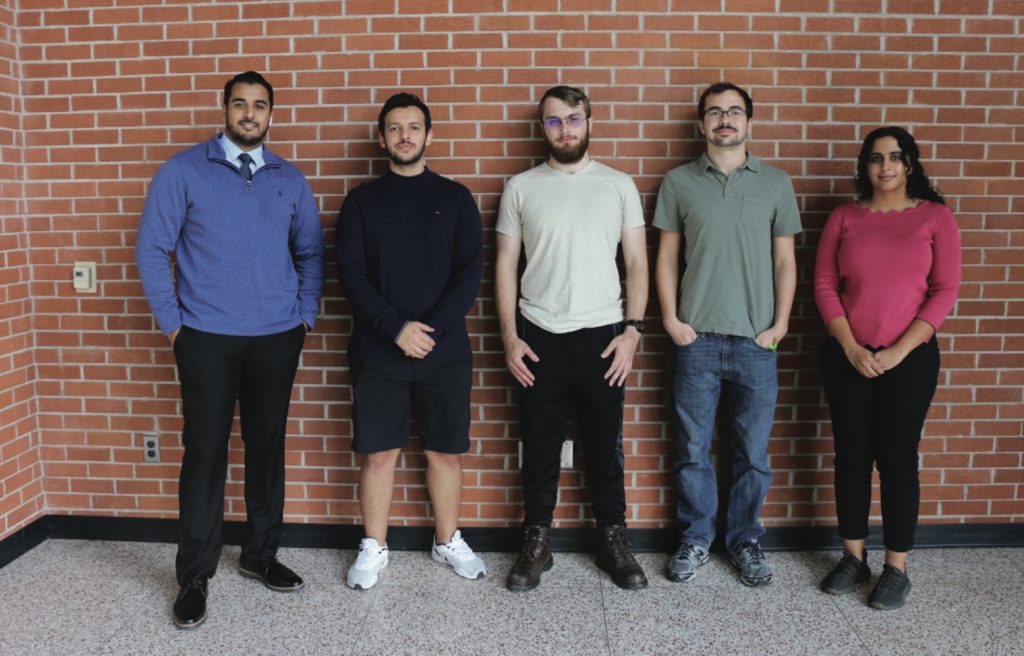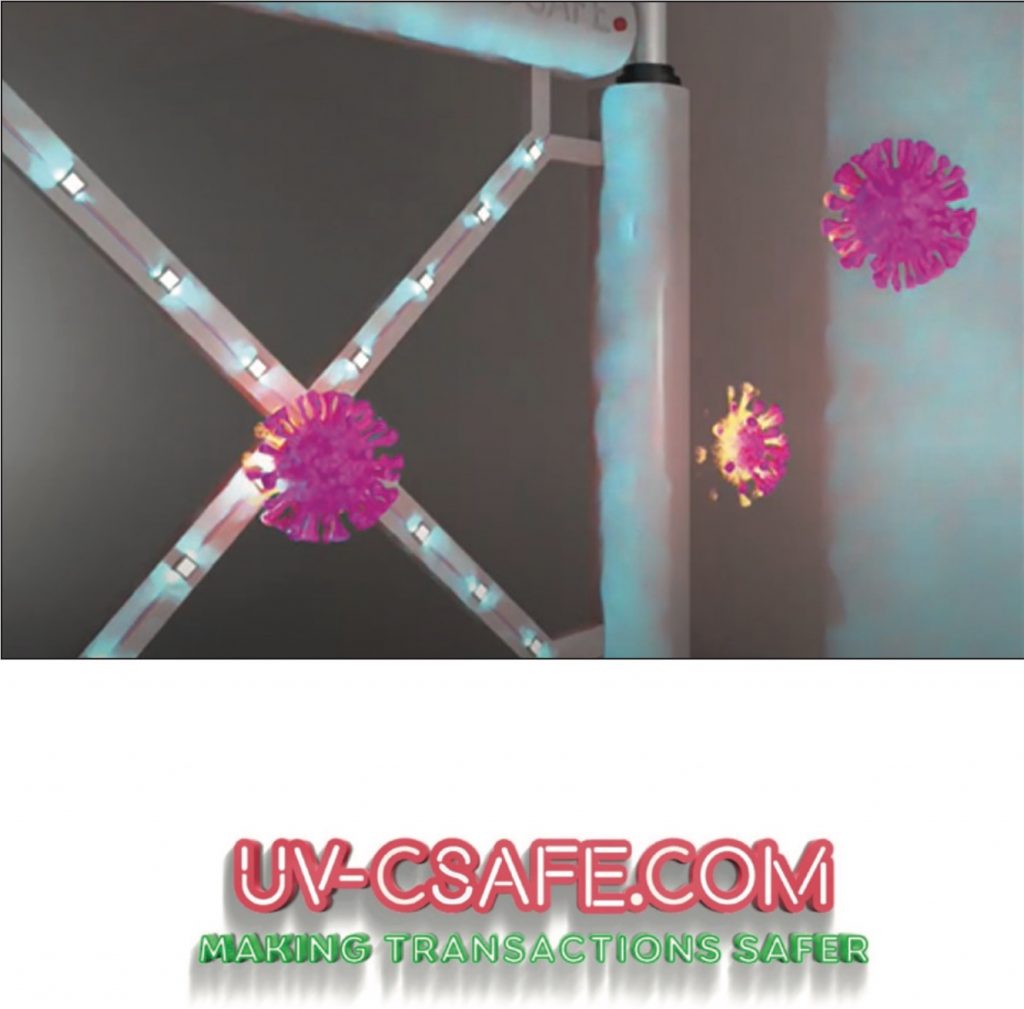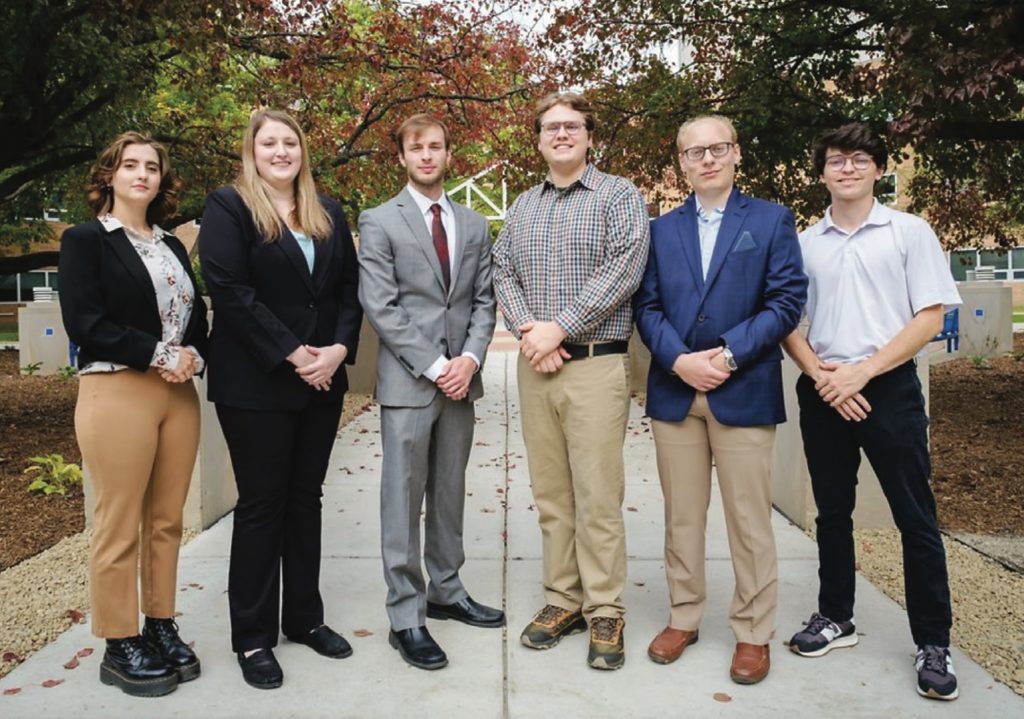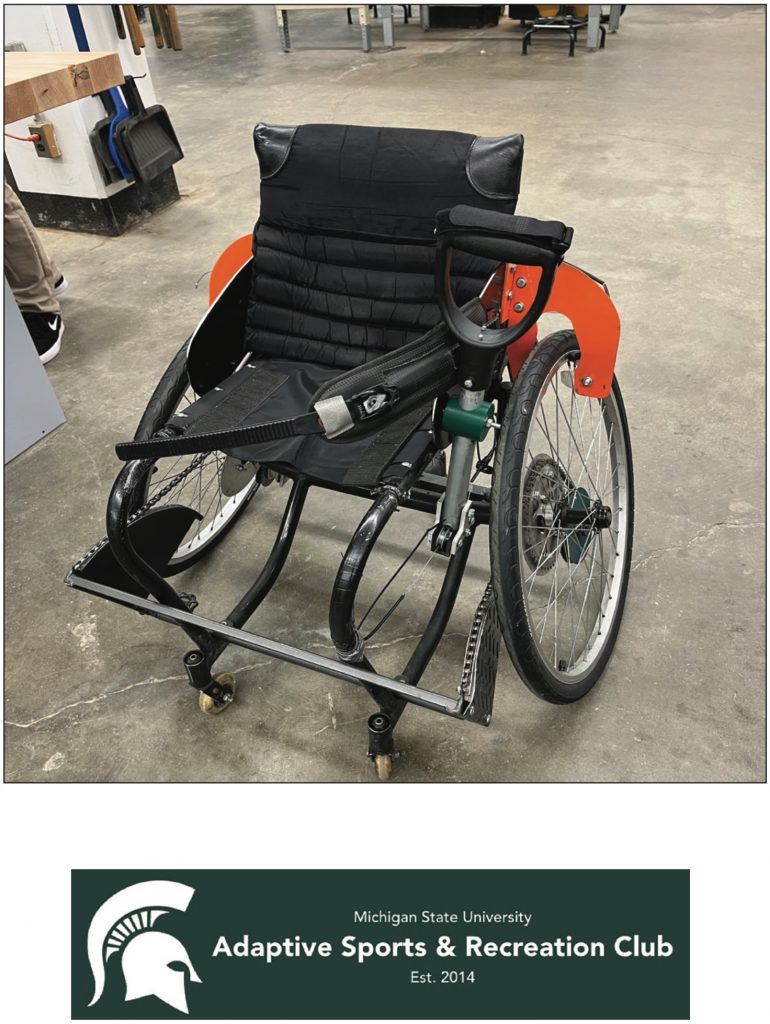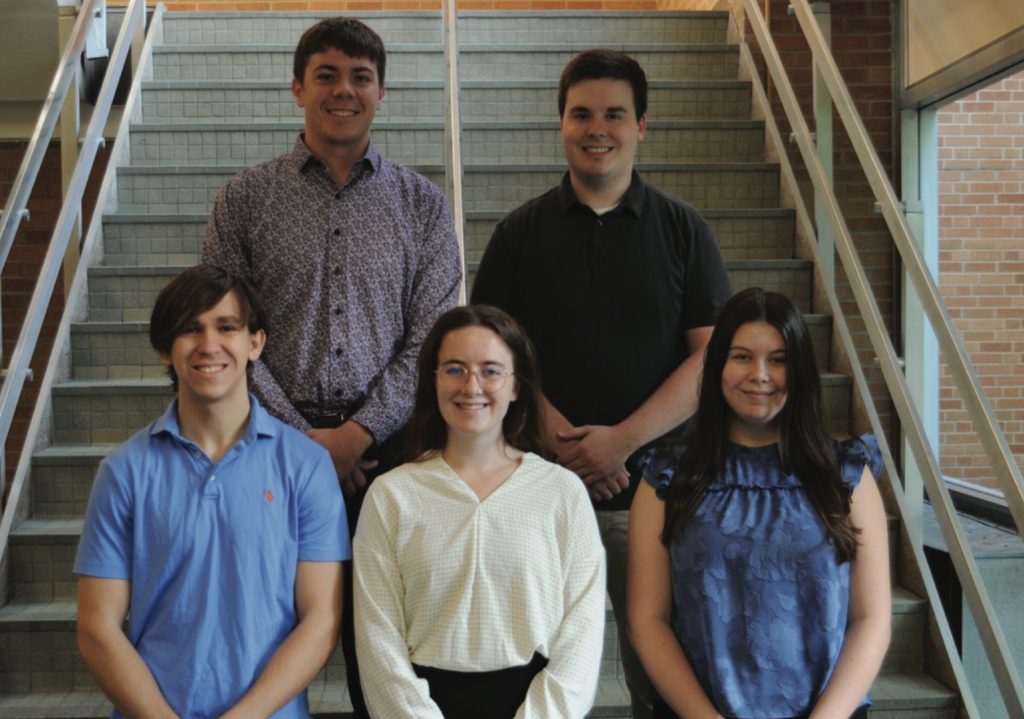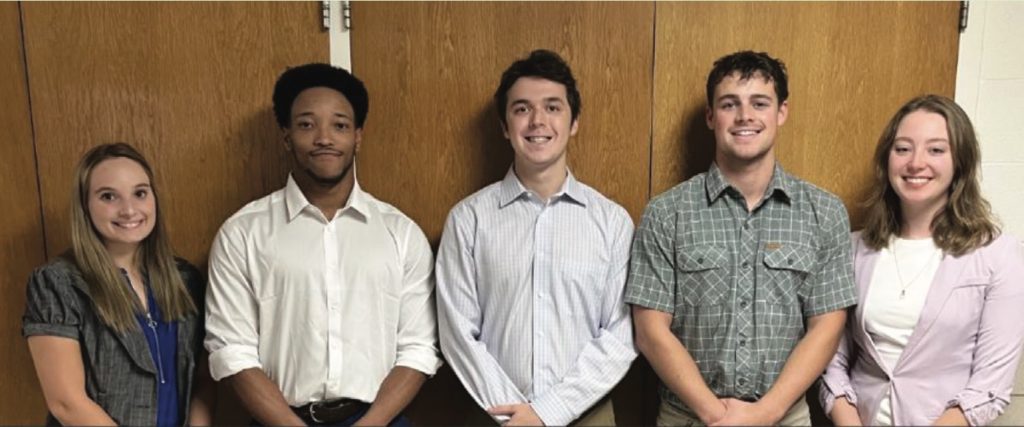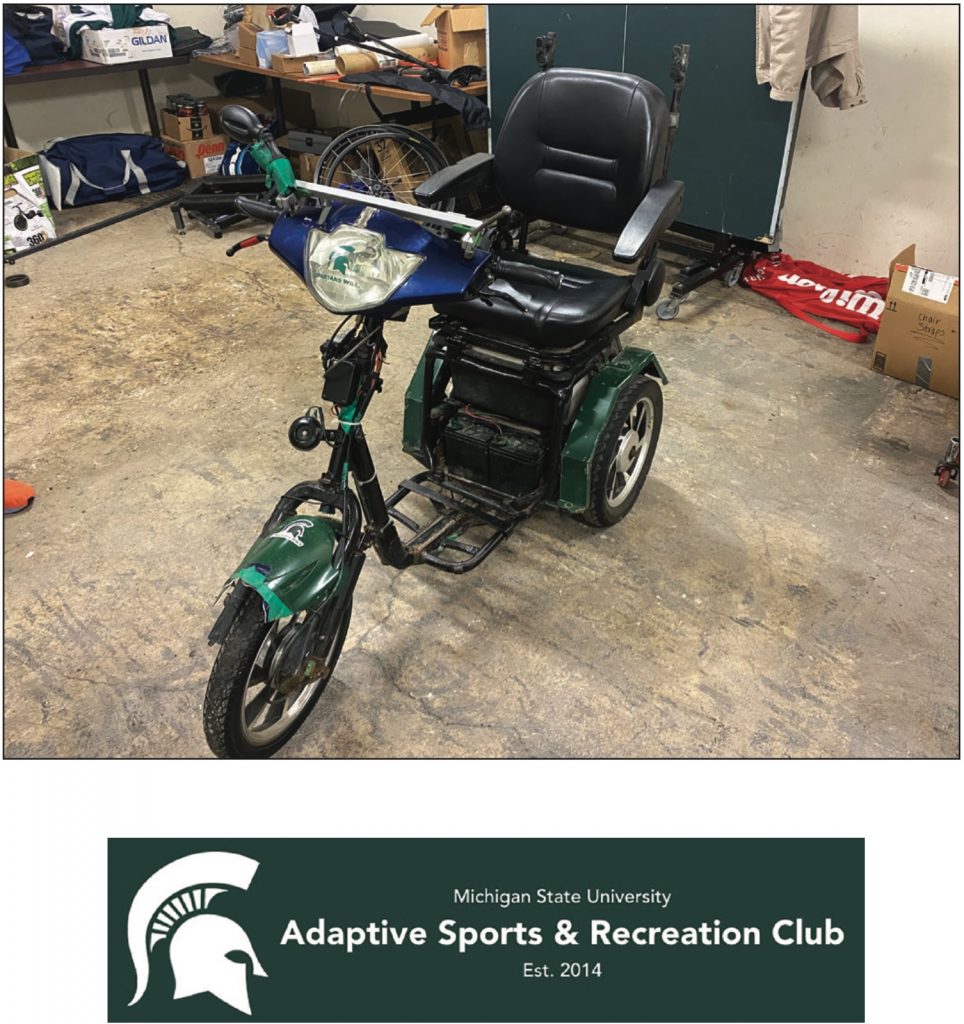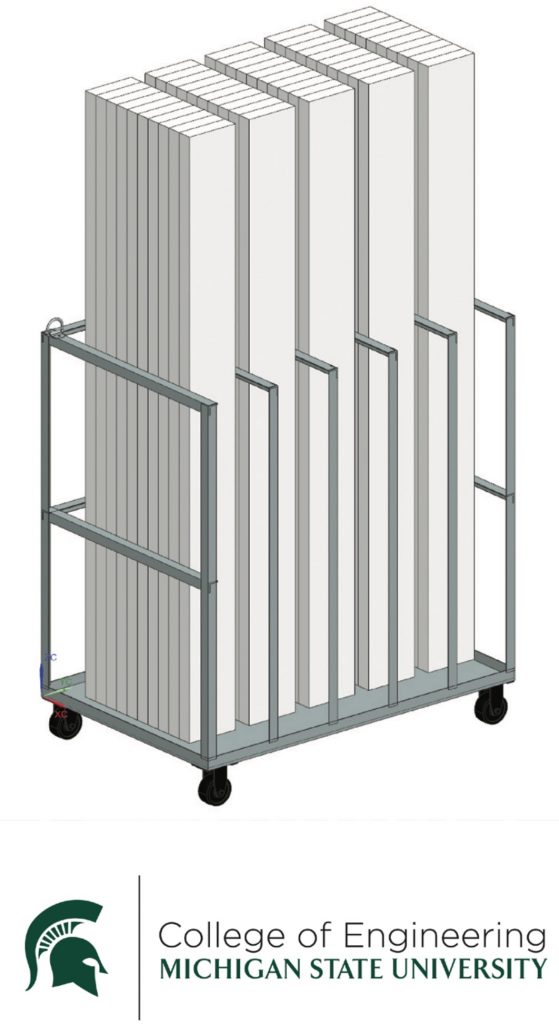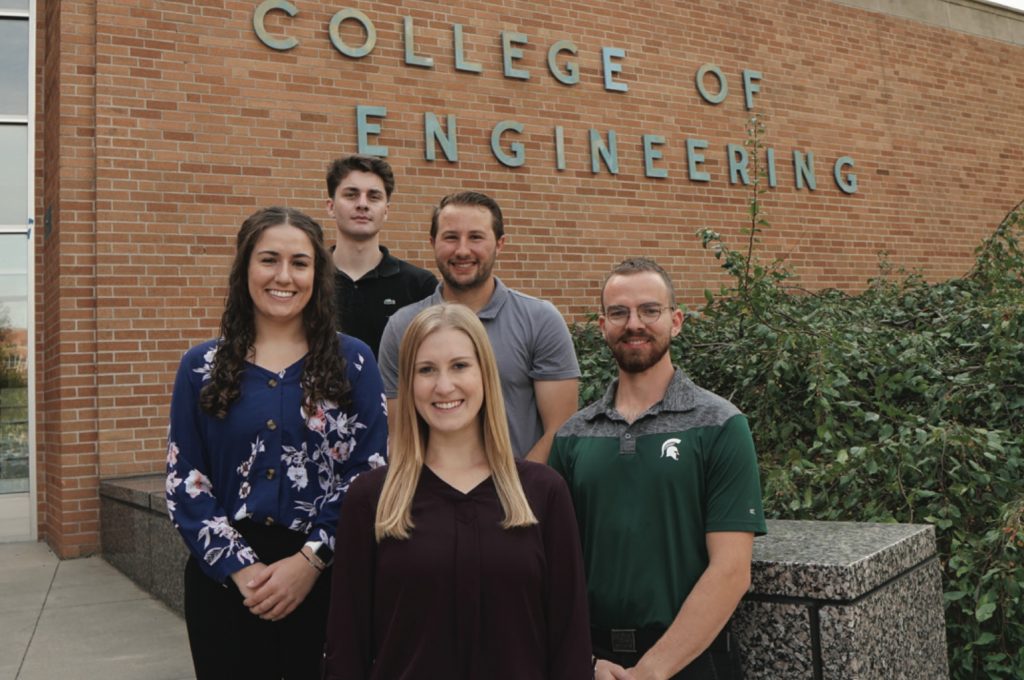Cleveland-Cliffs, Inc.: Train Depress Scrap Awning
Cleveland-Cliffs, Inc.: Train Depress Scrap Awning
Kautex Textron: EV Battery System Impact Plate Design
Toyota Motor North America: Frontal Area Scanner
Toyota Motor North America: Automotive Child Restraint Detection Sensor
Adventures in Training with a Purpose: Directed Steps: Quick-Release Handle Design
Adventures in Training with a Purpose: Directed Steps: Ambulation Aid
Ingham ISD: Ready Student Lift
Ingham ISD: Device to Facilitate Self Installing Foot-Ankle Brace
Steelcase, Inc.: Threaded Fastener Backout Detection
Michigan AgrAbility: Adjustable Modular Tractor Step System
UV-C Safe, Inc.: Germicidal Transaction Portal
UV-C Safe, Inc.: Home Application
MSU Adaptive Sports & Recreation Club: Roller Hockey Sled Mobility: Phase III
MSU Adaptive Sports & Recreation Club: Inclusive Sports Wheelchair: Phase VII
MSU Adaptive Sports & Recreation Club: Sled Hockey Transfer Platform: Phase VI
MSU Adaptive Sports & Recreation Club: 3-Wheel Drive System for Scooter: Phase I
MSU College of Engineering: Mobile Storage for Easels
MSU College of Engineering: Easel Storage Cart Design
Cleveland-Cliffs, Inc.: Train Depress Scrap Awning
Cleveland-Cliffs, a fully integrated steel mill located in Burns Harbor, Indiana, is the largest flat-rolled steel company in North America and a leading supplier of automotive-grade steel. As a fully integrated mill, Cleveland-Cliffs handles all parts of the manufacturing process for their steel coils: mining iron ore pellets out of the ground, melting them down, and casting slabs of steel. These steel slabs are then rolled into sheets and wound up into coils, which can weigh upwards of 80,000 pounds. Cleveland-Cliffs is committed to environmental sustainability and conservation, so in the event that a piece of steel is scratched or damaged it is collected as scrap that is later recycled and cast into a new coil.
Prior to being recycled, all scrap is collected into a pile in a scrap room, where it is then picked up by a large magnet and dropped into train cars. Occasionally, pieces fall into a gap between the car and the wall, where they are out of reach of the magnet. An employee has to pick up the pieces manually, which is hazardous because the pieces are both sharp and heavy. To solve this problem, our team designed an awning that hangs over the gap and deflects scrap into the train car, ensuring the area underneath remains clear. The awning was designed to attach to existing supports in the scrap room and to be able to withstand loads up to 2,000 pounds. It was also designed as a ten-foot section that can be easily repeated for the full, 50-foot length of the train depress. Because of the large size, special care was taken to keep the awning as simple and cost-effective as possible while maintaining a strong structure. By implementing this awning, Cleveland-Cliffs is not only able to keep their employees safer but also maintain production speeds as no time is spent waiting for scrap to be retrieved manually.
Michigan State University
Team Members (left to right)
Michael Strong
Jackson, Michigan
Robert Walston
Highland, Michigan
Sean Cornellier
Novi, Michigan
Charley Jiang
Fujian, China
Gianna Andriacchi
Chicago, Illinois
Cleveland-Cliffs, Inc.
Project Sponsors
Lauren Hart
Burns Harbor, Indiana
ME Faculty Advisor
Dr. Norbert Mueller
Cleveland-Cliffs, Inc.: Train Depress Scrap Awning
Cleveland-Cliffs is the largest flat-rolled steel company in North America and the largest supplier of automotive grade steel in the U.S. The company is a fully integrated steel mill from mined materials, to primary steelmaking, to downstream stamping, tubing, and tooling. The main goal is to become North America’s leader in steelmaking sustainability by reducing waste, improving water conservation, and reducing carbon emissions by 25% by 2030. Cleveland Cliffs sells mostly steel coils, and the average weight of a coil is between 50,000 and 80,000 pounds.
Our project focused on improving the process for recycling scrap steel. When recycling scrap pieces of steel to melt and insert back into the process, a large magnet picks up scrap pieces and drops them into a train car. Occasionally, the pieces of steel fall between the train cars and the wall. Originally, the fallen pieces would need to be manually retrieved. Our project focused on designing an awning to remove the need to send a person to retrieve the stray pieces. The awning would be attached between the wall and train car to deflect pieces of steel that would have fallen into the gap between the train and wall back into the train. For the scrap awning we made CAD drawings, FEA tested it with 1,000 pounds of weight, and made it as safe as possible.
Michigan State University
Team Members (left to right)
Ali Al Brahim
Alahsa, Saudi Arabia
Kyle Pawlowski
Clinton Township, Michigan
Sepehr Hosseinkhani
Canton, Michigan
Cole Treece
Clinton Township, Michigan
Ryota Yoshida
St. Clair Shores, Michigan
Cleveland-Cliffs, Inc.
Project Sponsors
Lauren Hart
Burns Harbor, Indiana
ME Faculty Advisor
Dr. Sharon Xiao
Kautex Textron: EV Battery System Impact Plate Design
Kautex Textron is a Tier One automotive supplier engaged in the manufacturing and development of traditional and hybrid fuel systems, thermoplastic composite, composite-metal hybrid battery systems, etc. With the growing demand for electric vehicles, automotive companies are introducing new electric vehicles in their portfolios and increasing their production of electric vehicles. The battery system is one of the most essential components in an electric vehicle. Thus, protecting the battery system from hazards while driving in different road conditions is the utmost priority to increase the safety, longevity, and performance of electric vehicles.
Our project was to design an impact plate to protect an electric vehicle battery system from road hazards and rough terrain. Various combinations of material types, material thicknesses, and impact energies were used to analyze the performance of the impact plate. The goal was to minimize the weight, cost, and deflection of the plate while at the same time maximizing the impact energy the plate can withstand. Different materials, thicknesses, and impact energy values were used to determine the optimal solution to ensure that the battery has the best protection. Ansys Workbench was utilized to simulate the trials that aided in the determination of the design with the most optimal combination of variables.
Michigan State University
Team Members (left to right)
Conner Cadieux
Farmington Hills, Michigan
Spencer Stefani
Grosse Pointe Farms, Michigan
Kyle Anulare
New Baltimore, Michigan
Jacob Demski
Brighton, Michigan
Parang Khanal
Lansing, Michigan
Dino Iovtchev
Walled Lake, Michigan
Kautex
Project Sponsors
Peter Ellwood
Troy, Michigan
Gareth Mayville
Troy, Michigan
Utsav Panchamia
Troy, Michigan
ME Faculty Advisor
Dr. Giles Brereton
Toyota Motor North America: Frontal Area Scanner
Toyota Motor Corporation is a multinational car manufacturer that was incorporated in 1937 in Japan, where the multibillion dollar company is currently headquartered. Toyota is one of the world’s leading automotive manufacturers, boasting a production rate of around ten million vehicles per year. Toyota strives to pilot the future of mobility and provide society with the safest and most responsible ways of travel. With this mindset, Toyota has become globally known for its dependable, durable, and high-quality cars, vans, and trucks. The performance division within Toyota’s Research and Development sector is responsible for validating designs to ensure that they are reliable and exceed expectation. Furthermore, a prevalent design challenge that Toyota and competing companies face is understanding and reducing the effects of drag on a vehicle. For an object moving through a fluid, such as air, a key factor in the total amount of aerodynamic drag produced by the object is the vehicle’s front facing area.
The project was to develop an automated system to determine the frontal area of a vehicle through optical or laser sensors. The system needed to minimize error, maximize efficiency, and be easily portable. Our team addressed these requests from Toyota to further improve the accuracy and time efficiency of a vehicle frontal area scanning system.
Michigan State University
Team Members (left to right)
Shamit Topiwala
Macomb, Michigan
Suven Sinha
Barrington, Illinois
Ethan Keppy
Waterford, Michigan
Frederick Bruner
Lowell, Michigan
Evan Backer
Kalamazoo, Michigan
Ash McKesson
Walkerton, Indiana
Toyota Motor North America
Project Sponsors
Nic Evans
Ann Arbor, Michigan
Aditya Ghawre
Ann Arbor, Michigan
Jesse Rydell
Ann Arbor, Michigan
ME Faculty Advisor
Dr. Ranjan Mukherjee
Toyota Motor North America: Automotive Child Restraint Detection Sensor
Toyota’s vision is to “lead the future mobility society, enriching lives around the world with the safest and most responsible ways of moving people.” From roadside assist to pre-collision systems with pedestrian detection, Toyota has prioritized safety when designing its vehicles. Always innovating and looking for new ways to add additional safety to their products, it is now searching for a way to further protect families and their infants on the road and in the backseat.
With this mission in mind, our team focused on designing a sensor system that detects the presence and type of passenger. Specifically, our sensor system determines if there is a rear-facing child restraint installed in the backseat of a vehicle. Toyota does not currently have a frontal airbag system in the backseat; however, this may change with the move to autonomous vehicles. Proper identification of the occupant will enable the car to signal how this airbag should deploy in the presence of a crash. Current frontal airbag systems, like those for the front passenger seating position, can pose a significant risk for children in car seats, particularly when rear-facing. With this sensor system installed, the car will signal the airbag to deploy with less force or not deploy at all. Not only does this system increase infant safety during crashes, but it also relieves some issues with regards to the seatbelt alert system. Most vehicles manufactured after September 1, 2002 are required by law to use low anchor tethers for child safety restraints called “LATCh” hardware. This hardware does not typically come with any type of sensing system. Occasionally, if a car seat is installed with the LATCh hardware and not a seatbelt, a signal is sent notifying the driver that there is a passenger that needs to be buckled. This alert signal can be an annoyance to the driver. With our new sensor system in place, this signal can be avoided if a rear-facing safety seat is installed properly using the anchors and buckles.
Michigan State University
Team Members (left to right)
Jahzeel Alcantar-Gallegos
Michoacán, Mexico
Amber Bliven
Tecumseh, Michigan
Caleb Holtschlag
Bay City, Michigan
Madysyn McKown
Flushing, Michigan
Kainnon Vilminot
Howell, Michigan
Toyota Motor North America
Project Sponsors
Jennifer Pelky
Saline, Michigan
ME Faculty Advisor
Dr. Elisa Toulson
Adventures in Training with a Purpose: Directed Steps: Quick-Release Handle Design
Founded in 2015, Adventures in Training with a Purpose (ATP) was created to confront health and movement-related issues within underrepresented communities who lack the resources necessary to receive proper paid rehabilitation. ATP is a nonprofit 501c(3) organization with the idea of working towards a society where no individual must be held prisoner by the limitations of their health. Adventure represents a journey that has no intention or guarantees but holds the promise that it will be meaningful and eye opening. Training enables individuals to strengthen both their mind and body, giving them more freedom of movement.
Our Quick-Release Handle serves the purpose of providing freedom to patients with movement issues. For these patients, a fall can cause serious injury. While operating ambulation aids, patients will often find themselves caught up in them when falling. Our design serves to remedy this issue by releasing the forearm cuffs from the ambulation aid to allow patients to extend their arms and catch their fall. With our design, ATP clients will be able to regain their independence using crutches that prioritize their safety.
Michigan State University
Team Members (left to right)
Parker Morris
Rochester Hills, Michigan
Elco Blanco
Rochester Hills, Michigan
Qixian Chen
Beijing, China
Nicholas Montpas
Flushing, Michigan
Hyun Kim
Troy, Michigan
Adventures in Training with a Purpose
Project Sponsors
Jon Kolb
Wexford, Pennsylvania
ME Faculty Advisor
Dr. Elisa Toulson
Adventures in Training with a Purpose: Directed Steps: Ambulation Aid
Adventures in Training with a Purpose (ATP) is a non-profit organization that aids people in refining their bodies, minds, and souls. Their focus is on those who lack insurance coverage for long- term pain and disabilities. Their mission statement declares that no one should be held back due to physical or mental health limitations and should be able to improve one’s quality of life through physical training. It is also important to ATP to give back to veterans and active military.
For this project, ATP is looking to help their clients that are not able to walk due to paralysis or neuromuscular deficiencies, through the development of a new type of crutch. Currently, when not using a wheelchair, the clients move forward by using large amounts of body strength to bring themselves up and forward. The goal of this project is to make movement without a wheelchair easier. The crutch has been in development for some time, including by past design project groups. The crutch is made up of three different sections: the handle, the middle, and the foot. This project focuses on the middle section. The proposal for the middle portion is to incorporate a spring in order to conserve energy and help the clients be able to push off the ground more easily while walking. It is also important to make sure to keep this part light and slim so that it is easy to move while in use. The middle portion then needs to be combined with other groups’ efforts in order to make sure the three parts can all work cohesively as one crutch. Our team primarily focused on a couple different clients with differing levels of movement in their upper extremities. Once the test clients are able to use the crutch easily, the design will be adapted to work with anyone who may have issues walking.
Michigan State University
Team Members (left to right)
Jackey Tran
Grand Rapids, Michigan
Erin Chynoweth
Davison, Michigan
Tung Nguyen
Ho Chi Minh City, Vietnam
Victoria Saxton
Saline, Michigan
Evan Lamb
DeWitt, Michigan
Adventures in Training with a Purpose
Project Sponsors
Jon Kolb
Wexford, Pennsylvania
ME Faculty Advisor
Dr. Lik Chuan Lee
Ingham ISD: Ready Student Lift
Ingham Intermediate School District (Ingham ISD) is a shared community resource that creates networks of support and enhances education for all learners in the service area. Ingham ISD has been partnered with Michigan State University’s Department of Mechanical Engineering for multiple semesters. Ingham ISD’s mission is to lead and serve to enable achievement and success of all learners. We plan to aid in this mission by improving upon the lift to create a more inclusive environment for students with disabilities.
This Ready Student Lift is a continuation of a spring 2022 design project. The project originally began as a lift for a particular student but has since evolved to be used for students with limited use of their limbs. This project came about out of a need for a safer, easy-to-use lift that could be easily maneuvered in the home or school setting. This lift will allow a single staff member to lift students without putting excess strain on their body. It will help staff to move students from their wheelchair to a classroom chair or toilet, which will allow students to fully participate in class activities. The goal of this project is to improve the current design and to ensure that it is safe to use. The lift specifications are that it must be able to lift a student weighing up to 150 pounds to a height of 30 inches. The lifting mechanism is a linear actuator which is operated by a remote control and powered by a 12-volt battery. Improvements were made to the frame to increase the structural integrity. Safety features were added to prevent pinch points and to ensure safe operation. Anti-tipping mechanisms were added to provide increased stability during the lifting process. These modifications increased the safety and usability of the lift while maintaining a small footprint, which will make it ideal for use in a school environment.
Michigan State University
Team Members (left to right)
Ethan Neitzke
Marysville, Michigan
Lukasz Morales
Grand Rapids, Michigan
Mert Ozmete
Ankara, Turkey
Nicholas Crane
Royal Oak, Michigan
Saeha Lederle
Clarkston, Michigan
Ingham ISD
Project Sponsors
Brian Grew
Mason, Michigan
Joanne Janicki
Mason, Michigan
ME Faculty Advisor
Dr. Tom Pence
Ingham ISD: Device to Facilitate Self Installing Foot-Ankle Brace
Ingham Intermediate School District is a regional educational service agency that works with 12 schools across seven counties, providing support for preschoolers, students with special needs, their families, and educators. They collaborate with these schools through hundreds of programs and services to give every student a chance to succeed as a learner. One group of students they work with are students who require physical therapy due to physical limitation. Ingham ISD therapists work with students in the local districts to help them achieve independence with functional tasks
Our team was asked to modify and improve a device that would hold an ankle foot orthosis (AFO) steady while a user is attaching the brace to themselves. The project was assigned to help one particular student who had developed Rapid Onset Dystonia Parkinsonism. This device allows him to safely insert his foot into his brace and use the other side of his body to secure the brace himself. It has been designed such that it can be employed universally by users with a multitude of conditions that would require an AFO. At the request of Ingham ISD, the device has been modified such that it can be mobile and more stable, as well as having the ability to adjust the angle of the orthotic rest plate. To make the device more mobile, a set of easy-lock wheels was added to the bottom of the device. An easy-turn knob system was added to adjust the height and allow for more variation in the possible set heights. The angle adjustability was improved by adding a pin system to allow the device to be secured at a desired angle and the stability was improved by using aluminum for support items in the scissor jack.
Michigan State University
Team Members (left to right)
Kobie Davis
Oak Park, Michigan
Eric Ernvall
Brooklyn, Michigan
Donnie Schuster
Macomb, Michigan
Matthew Davidson
Zurich, Switzerland
Daniel Vance
Romeo, Michigan
Tommy Wierzbicki
Macomb, Michigan
Ingham ISD
Project Sponsors
Christina Wolfe
Mason, Michigan
ME Faculty Advisor
Dr. Farhad Jaberi
Steelcase, Inc.: Threaded Fastener Backout Detection
Steelcase Inc., headquartered in Grand Rapids, Michigan, offers products in furniture, architecture, and technology aimed to help people reach their fullest potential. Steelcase has a vast product portfolio, including but not limited to seating solutions, tables, desks, and storage solutions. The furniture developed by Steelcase is inspired by innovative research in workspace design. A critical step in designing furniture is ensuring a product will not fail during customer usage. Steelcase performs furniture testing and validation at their Innovation Center in Grand Rapids.
Steelcase has been experiencing issues with threaded fasteners backing out, causing failures during customer usage. This problem is prevalent in a variety of different furniture products and has yet to be easily replicated at Steelcase’s Innovation Center. Due to Steelcase’s large product portfolio, our team was tasked with creating a universal test fixture and method capable of reproducing bolt backout. The test method must also consider a variety of different threaded fasteners, joint designs, and materials.
Understanding the different fastener types along with their properties, fastening orientations, locking mechanisms, and joint types were all critical to determining the appropriate test method. Testing methods considered were cyclic loading, alternate cyclic loading, and vibrational stressing.
Steelcase was also interested in improving their testing methods by investigating a virtual method that will simulate threaded fastener backout, eliminating physical testing at Steelcase’s Innovation Center to a modeling method such as Finite Element Analysis. Therefore, investigating possible methods was also important for this project.
Michigan State University
Team Members (left to right)
Spencer LaBuda
Oak Park, Michigan
Bryce Hitchcock
Dorr, Michigan
Peter Phan
Haslett, Michigan
Miguel Jarquin-Lopez
Palo Alto, California
Thomas Supal
Grosse Pointe Woods, Michigan
Steelcase, Inc.
Project Sponsors
Paul Mckay
Grand Rapids, Michigan
ME Faculty Advisor
Dr. Andre Benard
Michigan AgrAbility: Adjustable Modular Tractor Step System
Michigan AgrAbility provides services to farmers around Michigan with disabilities, illness, or aging conditions so they can continue to work. Through the partnership with Michigan State University and Easterseals, Michigan AgrAbility wanted to develop an easier and less expensive way for aging farmers around Michigan to get into their tractors. The bottom steps of farm tractors are typically 22” above the ground. While this is necessary to maintain high ground clearance, it is almost impossible for a farmer with a leg or back injury to climb into the tractor.
Our team was tasked with perfecting a preliminary prototype of an adjustable modular tractor step system that could be an after- market product installed on tractor ladders to help farmers with disabilities continue to do the work they love. The step system is designed to hold over 400 pounds and be robust enough to withstand the farm terrain. The top plate that bolts to the underbody of the operator station floor was designed to be adjusted in two planes in a such way that the system can be easily adjusted based on the type of tractor until the optimal angle of the 2”x2” spine is found. The individual tractor steps were developed with three pinholes. The pinholes allow the steps to be adjusted to find the optimal step angle based on the angle of the spine coming off of the operator station floor. The 2”x2” spine was designed with an inspiration from an adjustable weightlifting bench. The grooves in the back side of the spine will allow the steps to be moved based on the individual farmer’s needs and once the optimal step height is found, the grooves in the spine coupled with the pin in the steps will lock the steps in place. The team’s adjustable modular tractor system will help make sure farmers with leg injuries, arthritis, and other disabilities can continue working.
Michigan State University
Team Members (left to right)
Jeremy Balzer
Commerce, Michigan
Seth Gower
Bay City, Michigan
Robert Paquette
Saginaw, Michigan
Zachary White
Hanover, Michigan
Luke Willemsen
Wolverine Lake, Michigan
Michigan AgrAbility
Project Sponsors
Ned Stoller
Grand Rapids, Michigan
ME Faculty Advisor
Dr. Indrek Wichman
UV-C Safe, Inc.: Germicidal Transaction Portal
UV-C Safe is a company that uses ultraviolet light with wavelength up to 400 nanometers to disinfect products, surfaces, and air from germs and viruses. The goal of the UV-C Safe products is to minimize the spread of germs and viruses and create a safe environment to prevent the spread of diseases. The Germicidal Transaction Portal uses a UV-C Safe light that can be attached to sneeze guards at transaction points to make them safer.
The Germicidal Transaction Portal helps sanitize the area its light is directed at without any human interference or effort. The goal of our team was to increase accessibility to this product due to its efficiency in limiting viruses and bacteria transmission in crowded places. To ensure that the product serves as many people as possible, we designed a holder that can be attached to most of the commercial sneeze guards that are on the market. The design was created to be simple in terms of installation and mounting, since the UV-C Safe light is going to be installed by the consumer.
Michigan State University
Team Members (left to right)
Abdulhamid Salem
Coldwater, Michigan
Abdulkareem Alasmari
Jeddah, Saudi Arabia
Justin de Coster
Salem Township, Michigan
Bill Altier
Oak Forest, Illinois
Renad Alhassani
Jeddah, Saudi Arabia
UV-C Safe, Inc.
Project Sponsors
Rik Hudecheck
Grosse Pointe Park, Michigan
ME Faculty Advisor
Dr. Harold Schock
UV-C Safe, Inc.: Home Application
The COVID-19 pandemic has brought a drastic increase in sanitation efforts and methods to combat the spread of germs and viruses. UV-C Safe’s mission is to create the most innovative quality-of-life solutions. By engaging in a multifaceted, technology-based, non-pharmaceutical, pandemic countermeasures within the fields of research, design, manufacture, and sale of photon and proton management solution technologies, UV-C hopes to mitigate the impacts of epidemics and prevent future pandemics. One such technology is UV-C. Ultraviolet light in the C Spectrum, or UV-C, is energy rich light with a wavelength of 10 nanometers to over 400 nanometers used to clean air and the surfaces of objects.
Our team was tasked with designing a mounting solution for UV-C lighting technology to be used within a standard home cold air return. Placing UV-C lighting in this area allows for the passing air to be disinfected and safer. The design was to be simple and flexible in mounting options, as cold air returns vary greatly from household to household. We focused on designs that would have minimal blockage of airflow together with a large quantity of the air being exposed to the disinfecting UV-C light. Additionally, our design was to have the lighting face into the HVAC ducting, as UV-C can be potentially harmful to the eyes, so safety was a very important design factor. The ideal version of this product was cost-effective and easily installed by the user.
Michigan State University
Team Members (left to right)
Ben Abdallah
Commerce Township, Michigan
Kendall Lusk
Sterling Heights, Michigan
Drew Tyrrell
Lake Orion, Michigan
Joseph Deschaine
Clarkston, Michigan
Jack Rutkowski
Harrison Township, Michigan
UV-C Safe, Inc.
Project Sponsors
Rik Hudechek
Gross Pointe Park, Michigan
ME Faculty Advisor
Dr. Neil Wright
MSU Adaptive Sports & Recreation Club: Roller Hockey Sled Mobility: Phase III
MSU’s Adaptive Sports & Recreation Club is a free program offered to people who have physical disabilities so they can participate in a range of adaptive sports and games. The club was founded in 2014 and has been a leading program in creating a safe and enlightening environment for those with disabilities, and able-bodied volunteers, enabling them to experience sports from an inclusive perspective. The club also promotes a healthy lifestyle and promotes self-esteem in its participants.
Our team’s task was to improve the club’s adaptive roller hockey sleds to become more inclusive and mobile for players in Demonstration Hall where practices and games are held. It is the club’s goal to use these sleds instead of the wheelchairs being currently used. However, the previous design still needed significant improvement in order to accomplish desired mobility levels. This sled design expanded on the previous Phase II design. The motivations of our design changes were based on improving the mobility of the sled, the comfort levels of the user, and the inclusivity of the overall design. Our changes included removing excess material to decrease the weight of the sled, replacing select wheels with better alternatives, and improving the traction when used on the Demonstration Hall floor surface. Iterative design testing was conducted to assess the effectiveness of each of the design changes.
Michigan State University
Team Members (left to right)
Bryn Dittmar
Brighton, Michigan
Julia Fox
St. Johns, Michigan
Nathan Clarke
Eaton Rapids, Michigan
Mason Chorpenning
Lansing, Michigan
Alex Feige
Midland, Michigan
John Dibella
Troy, Michigan
MSU Adaptive Sports & Recreation Club
Project Sponsors
Piotr Pasik
East Lansing, Michigan
ME Faculty Advisor
Dr. Mohsen Zayernouri
MSU Adaptive Sports & Recreation Club: Inclusive Sports Wheelchair: Phase VII
The MSU Adaptive Sports & Recreation Club brings inclusivity to sports in the MSU and East Lansing community. Participants in this organization include individuals with physical disabilities, volunteers, and MSU project groups. The overarching mission of the MSU Adaptive Sports & Recreation Club is to provide opportunities for all individuals to experience the benefits of exercise including stress relief, increased physical health, and socialization. This program works to fight the societal limitations placed on individuals with physical disabilities by providing a supportive and welcoming community that is constantly innovating to create a place in sports for all people. While the MSU Adaptive Sports & Recreation Club has expanded opportunities in sports for many, there remains a gap in accessibility, particularly for ambulatory individuals with asymmetrical muscle function.
This project focused on the seventh phase of a customized tennis wheelchair for an ambulatory individual with asymmetrical functionality. Previous phases accounted for the needs of propulsion using the lower body due to the inability to rely solely on the arms. Additionally, the chair was designed to use the non-dominant arm for steering and braking to leave the dominant arm free for playing tennis. Safety mechanisms such as a seatbelt were also implemented. The seventh phase of the project focused on advancing the steering and braking systems to increase ergonomics and performance, as well as the propulsion system to increase practicality and efficiency. This phase of the project took the original state of the tennis wheelchair and advanced it to have increased personalization and effectiveness to meet the needs of the intended user more closely.
Michigan State University
Team Members (left to right)
Jericho Herblet
Ovid, Michigan
Jeremiah Waterman
Roscommon, Michigan
Tyler Marshall
Northville, Michigan
Natalie Knisley
Berkley, Michigan
Anna Citko
Beverly Hills, Michigan
MSU Adaptive Sports & Recreation Club
Project Sponsors
Piotr Pasik
East Lansing, Michigan
ME Faculty Advisor
Dr. Ahmed Naguib
MSU Adaptive Sports & Recreation Club: Sled Hockey Transfer Platform: Phase VI
The MSU Adaptive Sports & Recreation Club, is an organization that includes athletes and individuals with physical disabilities as well as volunteers and members of the greater East Lansing community. Within the adaptive sports community, promoting a physical and socially accessible space is a continually evolving task. The club has established an integrated community through a variety of sports, including sled hockey. While constantly promoting physical health, social behavior, and psychological wellness through adaptive sports, the club strives to provide a self-determination approach focusing on athlete autonomy, competence, and relatability. By doing this, the club has provided members with increased independence and enhanced quality of life leading to success both in sports and in other domains.
Our team focused on creating a way to secure the sled to the platform, improve the grab bars to increase stability while mounting the transfer platform, and create a safety stop for the winch mechanism to ensure that if there is a malfunction, there will be no damage done to the system.
Michigan State University
Team Members (left to right)
Jennifer Blowers
Kalamazoo, Michigan
Kearri Myrick
Stevensville, Michigan
Max Wiedemann
Clarkston, Michigan
Austin Pollock
Lowell, Michigan
Grace Vennstra
Shelby Township, Michigan
MSU Adaptive Sports & Recreation Club
Project Sponsors
Piotr Pasik
East Lansing, Michigan
ME Faculty Advisor
Dr. Seungik Baek
MSU Adaptive Sports & Recreation Club: 3-Wheel Drive System for Scooter: Phase I
The MSU Adaptive Sports & Recreation Club serves the community by offering a variety of recreational sports for players with physical disabilities. Health and teamwork are promoted through the use of sports. Some of these recreational sports include wheelchair hockey, wheelchair rugby, and adapted track & field. Participants have access to three on-campus buildings dedicated to recreational activities. These buildings include Jenison Fieldhouse, the MSU Tennis Center, and Demonstration Hall.
With the harsh weather conditions of Michigan, it can be difficult for individuals who use mobility scooters to travel to their destination. Our team was tasked with prototyping a three- wheel drive system for an existing scooter (E-Wheels EW-36). The three-wheel drive system is easily replicable, universal, and reliable. Navigating harsh winter weather conditions will now be less stressful with the added traction and power the three-wheel system provides. Phase I is a great proof-of-concept that provides a concrete platform for future design teams continuing to improve this scooter to ensure that the individual has a reliable mode of transportation year-round.
Michigan State University
Team Members (left to right)
Alex O’Reilly
Ridgefield, Connecticut
Ryan Peters
Romeo, Michigan
Jake Cuffaro
Chesterfield, Michigan
Atticus Crimmins
Romeo, Michigan
Kyle Zerafa
Romeo, Michigan
MSU Adaptive Sports & Recreation Club
Project Sponsors
Piotr Pasik
East Lansing, Michigan
ME Faculty Advisor
Dr. Abraham Engeda
MSU College of Engineering: Mobile Storage for Easels
Every semester, the College of Engineering hosts various events in which students present projects that they have been working on. One such an event is the graduate research symposium. Students create posters highlighting their projects or research and display these posters on five-foot-tall easels. The college has over 300 of these easels that are only used a few times per year for poster-centric events. They are stored in groups of fifty on repurposed carts (such as a cart formerly used to carry trays of food). All the carts were built with the sole purpose of moving fifty easels, with little attention to the users. Loading and unloading the carts is difficult and involves awkwardly lifting the five-foot easel over a four-foot railing. To be fully loaded, the current carts must be loaded very specifically.
Our team was tasked with designing a new cart to move the same number of easels with ease-of-use at the forefront of the design. This involved building a larger cart and not requiring the user to lift the easels over a railing. The storage facility where the easels are stored is not climate or rodent controlled. Rather than keeping the rodents out, the cart was designed to ensure any rodent visitors would be able to escape. Our team worked to design a cart that was simple and repeatable so future carts could be built based on this design.
Michigan State University
Team Members (left to right)
Mark McCloskey
Linden, Michigan
Patrick Marchal
Green River, Wyoming
Michael Bachleda
Farmington, Michigan
Katie McMillan
Monroe, Michigan
Meghan Parkinson
Rochester Hills, Michigan
MSU College of Engineering
Project Sponsors
Katy Colbry
East Lansing, Michigan
ME Faculty Advisor
Dr. Manoochehr Koochesfahani
MSU College of Engineering: Easel Storage Cart Design
The College of Engineering at Michigan State University is one of the oldest colleges on the campus, dating back to 1885. Its goal is to prepare students for the future challenges of business, industry, and academia. The College of Engineering is staffed with people from all around the world. They are valued for their leadership and teaching abilities, as well as extensive knowledge throughout engineering and the technological field. The College of Engineering consists of seven departments with eleven undergraduate degree programs and nine graduate degree programs.
The MSU College of Engineering owns 300 easels that are used for various poster symposia and other events a few times per year. One cart of 50 easels is stored in the Engineering Building, and five carts of 50 easels each are stored offsite in a “pod” that is not climate-controlled and tends to attract rodents. Presently, the easels are stored and transported in repurposed bakery racks, which do not meet their needs. Our project was to create a sturdy and portable cart design in which the easels can be accessed by people of varying heights. The easels need to be easy to remove and the carts need to be able to hold 50 easels/each.
Michigan State University
Team Members (left to right)
Cameron Dork
Rochester Hills, Michigan
Connor Laubach
Rochester Hills, Michigan
Luke Janecke
Williamston, Michigan
Andrew Pieper
Marquette, Michigan
Michael Gertley
Novi, Michigan
MSU College of Engineering
Project Sponsors
Katy Colbry
East Lansing, Michigan
ME Faculty Advisor
Dr. Sara Roccabianca


